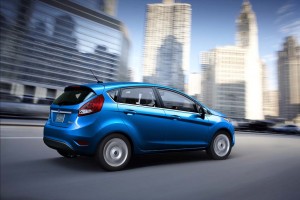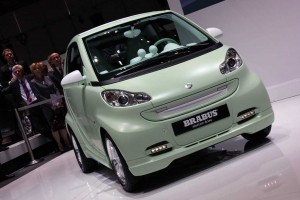
Like its cross-town rivals, Ford has struggled to make money on small cars but is betting it will with the 2011 Ford Fiesta, on sale next year.
For many decades, Detroit has been trying to figure out how to make money on a small car in the U. S. Even the definition of what a “small car” is has changed over the years. In 1959, when the Falcon, Corvair and Valiant “compacts” were introduced to stem the flow from Europe, they were known as “small cars.”
Today, the definition of a small car is still fuzzy both within and without the auto industry.
We’d all agree the smart fortwo and the Fiat 500 are small cars. Ford and some others label these “A” cars. I’ve never seen a formal definition, but their overall lengths (OAL) are 106 and 117 inches, respectively.
The most successful of the Big Three’s 1960 “small cars,” the 109.5-inch wheelbase Falcon, for comparison, had 181″ OAL, while the VW Beetle it was designed to drive from the shores was 160″ OAL. George Romney’s 100-inch wheelbase Rambler American was 178″ OAL.

American makers aren't the only ones struggling to make money with small cars. Daimler hasn't found the formula with smart, either.
The next step up in categorizing size of today’s cars would be, obviously, “B” cars, such as the forthcoming Ford Fiesta and 2010 versions of Chevy Aveo, Kia Rio, Honda Fit and Toyota Yaris. These all seem to have OALs around 170 inches and wheelbases of 98 inches.
Then there are “C” cars such as the Ford Focus, Chevy Cobalt, Honda Civic and Toyota Corolla, with OALs of 175 to 180 and wheelbases from 103 to 106.
The next category larger are “D” cars such as Ford Fusion, Mercury Milan, Lincoln MKZ, Chevy Malibu, Honda Accord and Toyota Camry, altogether these days the volume part of the market, but not “small cars” anymore even though in 1960 they would have been counted as such.
Indeed, there’s been a long history of failed attempts by American automakers to import small cars from Europe successfully. Probably the first was Bantam’s U.S. version of the British Austin in the 1930s. Postwar was the big period of Ford imports from Britain, beginning with right-hand-drive English Fords, which resulted in a memorable Bill Mauldin (“Up Front” with Willie and Joe) cartoon of a RHD English Ford driver on an American two-lane road, trying to lean over far enough to the left to see to pass a slow-moving truck. English Fords constituted the largest number of imports in the Forties and Fifties until they were displaced by MG, then VW.
In the late Fifties, responding to VW growth, Ford imported such cars as the English Ford Anglia for Ford dealers and the German Ford Taunus for Mercury dealers, while GM brought in Vauxhalls for Pontiac and Opels for Buick dealers. American Motors imported its version of the Austin in unique coupe and roadster body styles, calling it the Metropolitan. In later decades right up into the Nineties in some cases, Ford imported British Ford Cortina. German-built Capri and Merkur SR4ti sports coupes and Scorpio luxury sedans, and finally Australian-made Americanized versions of the Mazda Miata roadster, all for Mercury dealers–and all flops. Most notable was the U.S. version of the European FWD Ford Fiesta, of which some 264,00 were sold from 1977 to 1980 by Ford dealers; sales were limited by the lack of an automatic transmission at a time when only some 10 percent of Americans bought cars with stick shifts.
There has been a lot of hoopla about domestic small cars lately. Ford has led the parade with clever pre-sale marketing of the Mexican-built 2010 Fiesta, scheduled to go on sale in the U.S. next summer. GM has announced it will begin assembling its Korea-based Chevrolet Aveo in 2011 at a plant north of Detroit previously building Malibu, while the shotgun marriage of Fiat and Chrysler says in 2011 it also will build tiny 1.4-liter four-cylinder engines at another Michigan plant for a new Mexican-assembled Fiat 500.
(The word out among the cognoscenti of Detroit is that the UAW and the White House rammed these plans down the throats of bankrupt GM and Chrysler, now on taxpayer life support.)
With all that history and news as a basis, then, let’s get down to the real subject at hand: how to make a profit on small cars in the American market.
There’s only two ways to make money on anything: volume and price.
Ford Motor Company’s plan to make money on the “new” Fiesta in North America seems to cover both fronts. For volume, for the first time since the Model A that went out of production in 1931, Ford will produce “One Ford” worldwide. The “One Ford” (CEO Alan Mulally’s description of his plan, like “One Boeing,”) will apply initially to both Fiesta and Focus. Whether made in Europe, the Americas or the Far East, these cars will be essentially identical, spreading costs over much larger volumes. For example, Ford aims at selling 50,000 Fiestas in the U. S. initially, but will make out with another 850,000 in the rest of the world where in some places there are rapidly growing volume markets—almost all for small cars. So that gets the volume necessary for a profit.
Then there is profit. Right now, the “C” class Ford Focus in the U. S. is sold in three series, SE, SES and SEL, and for the added or changed third initial in the model distinction label on the deck lid, there is a bump up in price along with appealing additions of standard equipment.
The same is planned for the new Fiesta: three series, beginning at $13,995 for a four-door sedan aimed at American buyers and $16,535 for the more European-like five-door. There will be no el cheapo three-door offered in the U.S.
But that’s not all, as the sucker TV ads proclaim.
In addition, Ford figures it will be able to command higher retail delivery prices with a slick option (lower series) or standard equipment (higher series) list of electronic gadgetry designed to appeal to the under-30 crowd who can figure out how to work it, like voice-operated “Sync” which has the Consumer Electronics Show crowd all agog in anticipation. Fully loaded then, Ford hopes a lot of Fiestas will depart U. S. dealership doors with upwards of $23,000 in delivered price.
Volume and price. Sounds like Old Henry, doesn’t it? Except Ol’ H lowered Model T prices to get more volume, and his great grandson Bill is being counseled to go for both volume and price (increase). And Bill’s previous financial performance as chairman resulted in his being moved aside to a largely ceremonial “executive chairman” role.
Will Fiesta’s (and in 2011 with a new model, Focus) volume and price strategy pay off? In Detroit parlance, will the dogs eat the dogfood? No doubt it will be helped by a resurgence in the economy, but Ford isn’t counting on that for its profits-from-small-cars plan.
Only Time Will Tell if it works
In the meantime, I wonder if GM and Chrysler can execute their small car strategies—if they have any, other than swallowing the sword being thrust down their throats—as well as Ford. As to Hyundai, Honda and Toyota, they’ve got public recognition already for good and cheap small cars, and with home-government backing, probably don’t really have to worry about making per unit profits on small cars.
